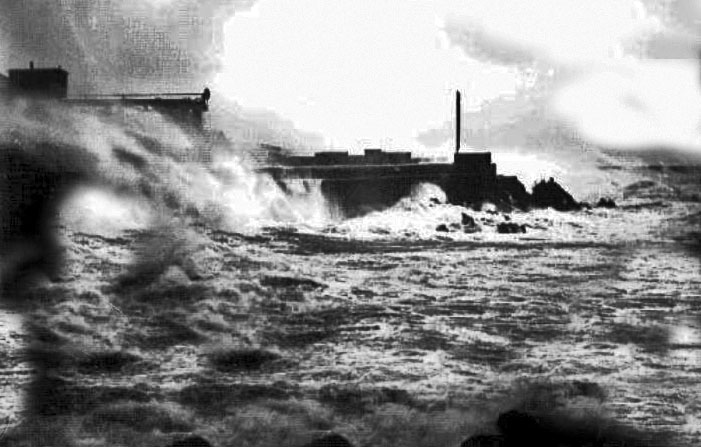The Societe Jersiaise photographic archive was established in 1873, they serve as an important resource providing information and artefacts on Jersey’s heritage open to the Jersey community. The material that is collected includes drawings, photographs, documents, paintings and records, making it much easier for people to look into the history and play a significant role in our cultural heritage. the archives play an important role on improving our knowledge of the past meaning having a more informed perspective on both the future and the present.
The impressive work of the archive to preserve the islands history has an impact on the local art scene which strengthens this connection between art and history, the Archisle contemporary art programme hosted by societe Jersiaise since its foundation in 2001 has commissioned renowned artists such as Martin Parr, Tom Pope and Michelle Sank which created artwork to create the vibe of Jersey.
What I really find fascinating is that the photographic archive captures a range of subjects such as documentation such as the islands wildlife, the geography of the island, images of the local population and also significant historical island events. Societe Jersiaise aims and goals are to (“produce and facilitate research on the Island’s history, culture, language, and environment; and to share that knowledge with the widest possible audience for the benefit of our island community”). And what I really like is how this is represented in the Societe active engagement with the local community. This engagement is an ongoing participation in community outreach programmes research initiatives and collaborations with various local partners. There are also conservation and care given to donated artefacts and the Societe members contribute significantly to the communities appreciation of its heritage. This community acts as a cycle of people giving material to be preserved allowing others to learn and inspire them to grow their knowledge and give back to the Societe.


While I was researching the history behind important figures of Societe Jersiaise I stumbled upon the name of Ernest Badoux. Born in 1828, he conducted his photographic work in jersey starting in 1829. Ernest had a total of 1350 of his images primarily focusing on portraits, these are accessible to view on the jersey heritage website. These portraits were only available for the wealthier inhabitants of the island. Although he did focus on portraits, these are some works of his which include landscaped, mainly client’s residences as well as documenting significant events happening at the time. These scenes when put together hold great value as they tell the story of the islands historical transformations. Because of the amount and quality of Badoux’s imagery, it is a greta resource for other people and it shows how the archives serve as a library of knowledge and experimental understanding.

This image, taken by Ernest Badoux in 1886 is one of the many interesting images produced by him but also another historic photograph that takes us back. Although there is not much actual history shown in the photograph meaning there is no specific landmarks or other historic scenery that makes the picture look vintage. With little infrastructure, it focuses on the natural beauty and wildness of the island, however this can be deceiving as the contents of the image itself do not reflect the time at which the image was taken like the other images that I came across which included victorian buildings and portraits of people. What made me choose this image is that although it is a very old image, it still shows the beauty of nature seen in the present day, it is showing one of the only aspects that remain the same. As the image is composed of mainly crashing waves and the violent sea, we can see a glimpse of vague infrastructure in the background. What I find interesting is that the same image image could be produced in the present day with the right equipment whereas other images freeze time, this one feels different as it is relatable to the present day. The photograph itself is bathed in soft hues of late 19th century, his composition skilfully balances the natural elements and human presence with the nature dominating the image but influence of human kind being shown through the buildings, this reflects Badoux’s signature approach of storytelling through images.
The play of the daylight and shadows reveals details casting a nostalgic glow over the waves and rustic architecture in the background. (Le Collete 1886) stands as a testament to Badoux’s ability to transcend the boundaries of a single frame, giving an emotional reflection on the historical aspect of Jersey but mainly timeless beauty in its landscapes.
When taking a leap into early photographic processes, such as daguerreotype, calotype, salt paper prints, wet plate collodion, albumen prints, autochrome and colour transparencies archival imagery is is great record of each . Ernest Badoux uded a chromotype process, also known as “carbon printing”. These produced a sepia tone print with a metallic-like finish. It is amazing that we are able to go back in time through the different processes and photographic evolution, by having records of it, enabled by the jersey archive, and archives all around the world.
In conclusion, the significance of photographic archives, are for the historical images that open many paths into the past, opening windows for peoples understandings of their origins and connecting with their artistic inspiration. For photographers, these archives hold very valuable resources as many photographers and artists incorporate archival material into their works. By people using archival images, it hightens the meanings of the paths and ensures the history is preserved and is not forgotten, this is a pivotal role of archives, shaping our perception of the island and its history. No matter if one is native to jersey, these archives hold significance in illustrating how our island once functioned. They serve as a vital compass guiding us through the historical maze of our island, making them an invaluable resource for our research and exploration.
